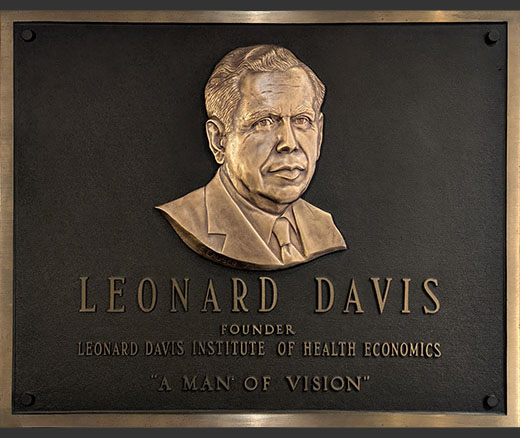
Black and Hispanic Children Have Higher Death Rates Than White Children After In-Hospital CPR
Equitably Improving Care for Hospitalized Kids Who Experience Cardiac Arrest Requires Hospital-Level Changes, LDI Fellows Say
News
The call for integrating physical and mental health care is not new, but in a half-hour keynote address to the October 29 Penn LDI virtual conference, Benjamin Miller, PsyD, provided one of recent memory’s most cogent and eloquent explanations of why and how that might be accomplished. The University of Pennsylvania event was titled “Mental Health Care in Flux: Exploring New Ways to Deliver Care.”
Miller’s Paul Starr-esque historic overview of how we arrived at the current ineffective policies opened an afternoon gathering in which nine other top experts detailed the research and innovative programs now seeking to address the mental health care system’s documented shortcomings. All concurred that the COVID-19 pandemic has spawned broad waves of stress, anxiety and need for mental health care that have drawn increased attention in policymaking circles. The conference was co-hosted by Penn LDI and the Penn Center for Mental Health.
Conference participants agreed that the primary keystone of the issue is that mental health care has long been tightly segregated from the rest of the health care system and, in its isolation, starved of resources and critical synergistic connections.

“We have decades of thinking of mental health as something that’s separate and distinct,” said Miller, who is President of the Well Being Trust Foundation, a non-profit founded by Providence St. Joseph Health five years ago to focus on clinical transformation, policy, and advocacy related to the mental health and social well being of the U.S. population.
“Despite some of the great work and great papers that many scientists have published,” Miller continued, “we still have this tangled mess of a mental health care system with fragmented parts that perpetuates this false divide between mind and body, mental and physical. We limit where a person can get access to care. We’ve got different rules for mental health coverage, financing, delivery, training and so on. And yet, despite year after year of data showing people are not getting care, we continue to build programs on top of programs which all use these ineffective policies.”
The Penn LDI conference in which Miller spoke occurred simultaneously with the publication of an op-ed article in The Hill by a team of researchers at Penn’s Center for Mental Health. Titled “It’s Time to Pay for Mental Health Care in America,” it was written by Emily Becker-Haimes and LDI Senior Fellows David Mandell, ScD, and Rebecca Stewart, PhD. The piece echoed Miller’s assessments:
“The mental health care system in this country is broken — if something can be broken that was never built properly in the first place. The United States has never invested in its mental health care systems the way that we have for physical health. Pitifully low reimbursement rates and chronic, systemic underfunding have led to a largely fractured, overworked, poorly-trained and poorly-paid workforce, leading to a significant shortage of mental health care providers. There are not enough providers at any level of training. Many mental health facilities are rundown and overcrowded, with long waitlists and poor access to care.”

Miller noted that one prism through which he analyzes the current mental health system is an admonition from Well Being Trust board member Maureen Bisognano that “once we realize something is not working, it’s unethical to proceed as if it is.”
The second half of Miller’s presentation focused on potential elements of restructuring in three mental health-related areas. They are:
1. Robust integration of mental health care and physical health care
“When we ignore mental health within our larger system, it’s less effective for our overall care,” Miller said. “I’d like to propose that we break our specialty mindset around mental health, a mindset that’s gripped us for too long, and really begin to shift from clinical settings to community-based settings like schools and other community venues. We’re always going to need specialty care, but our overreliance on specialty care has meant these longer wait times, increased costs to the person and to the system, as well as a dissatisfying experience. We must reassess our structures and begin to ask ourselves basic questions like ‘Are there policies or programs that limit where a person can get access to mental health care?’ If the answer to that is yes, it needs to be reconsidered. And I actually think by doing this exercise, we begin to unpack our structures and see how we manage, deliver, and pay for care. Only about one in 10 people with a substance use disorder receives treatment. And, according to another study by the Kaiser Family Foundation, about 40 percent of American adults continue to delay accessing health care because of concerns about cost, and four in 10 of those adults report having trouble even paying their deductible.”
2. Rethinking workforce policies and practices to better meet real need
“Let’s rethink our workforce with an eye to who does what, where and for whom,” Miller said. “Our current assumptions about where care is delivered might be wrong. Half of the country’s counties have no psychiatrist. Thirty-three percent of individuals who seek care wait more than a week to access clinicians. Some wait upwards of six weeks or longer. Fifty percent drive more than a one-hour trip to treatment locations, and the longer you have to drive, the larger the disparities are. What if the community, leveraging its relationships with clinicians, wants those clinicians in the places where that community’s members are — like in their homes or schools, libraries, barbershops, YMCAs and the like. It seems a major opportunity for us to both reimagine our workforce and what happens if each of us who are non-clinicians are equipped to handle issues of mental health? I’m convinced that this is a moment that allows us to be a bit more radical in how we think about workforce that’s really in community, by community, and for community.”
Miller called for the creation of “task shifting” policies that support the establishment of a corps of local community health worker-like lay personnel trained in low-level psychological interventions. The concept is already being successfully used as part of HIV and COVID-19 public health responses in other parts of the world.
“We need to look at places relevant to critical community conditions or social factors like housing, transportation, and racism that are driving underlying issues of mental health,” Miller said. “We need to democratize this knowledge and empower community members to have the skills to intervene with each other. This is a truly disruptive approach, but one that has been embraced by other countries and should be embraced here.”
3. Organizing and mobilizing a new constituency for mental health advocacy
“As scientists,” said Miller, “we should know that too much of our research, practice, and policy work is really only noticed by those people who diligently read the latest Health Affairs like myself. But that’s not enough. Our challenge is to better organize a new constituency for mental health bound by a common vision framework for advocating for a significant redesign of health care. My hypothesis is that the reason we don’t see our policy work being as transformative as we might like is that not enough phones are ringing in senators’ offices. We have to find those people who can make the calls, and who know folks who aren’t showing up at the meetings, the hearings, and the other places where advocates need to be. You may say, well, that’s not my job. That’s what the advocacy organizations do. Well, sure, they mobilize quite well, but there’s a fundamental difference between mobilizing and organizing. Organizing is knocking on the doors of the people who don’t know mental health is their issue and getting them on your team. Mobilizing is taking those people who have bought into the issue and directing them to do something different. Most mental health advocacy organizations mobilize quite well — the Capitol Hill visits, the action alerts, et cetera. But have we convinced enough people to organize? I believe this is where we have to adopt the vision and framing principles of social movements. This is really about what mental health advocacy can do to change hearts and minds. You have to have a constituency, you’ve got to have people, and you have to have a long-term commitment. We know that social movements are not episodic. They’re about long-term perspective and really investing in building relationships over time, including the next generation who can continue the work.”
“In closing,” said Miller, “I want you to think about your own life for a second — your loved ones, your family, your friends. What would you do if they asked you for help with a mental health situation? Would you know where to turn? Who to call, what to say? For most Americans, the answer is ‘no’ and we need to change that.”


Equitably Improving Care for Hospitalized Kids Who Experience Cardiac Arrest Requires Hospital-Level Changes, LDI Fellows Say

Six Studies That Highlight How Losing SNAP Can Raise Food Insecurity and Affect Health

Includes $1 Million in Donations to Meet a Matching Challenge

For Seven Years, Revenue Has Supported Education, Community Projects, and Better Health Outcomes

Government Regulatory Power Wanes as Power Accrues to Courts and Corporations

Temporary Shutdown Losses are Only the Beginning: New Rules Under the One Big Beautiful Bill Act will Shrink SNAP Benefits, and Worsen Food Insecurity for Millions Across the U.S.
Research Brief: Shorter Stays in Skilled Nursing Facilities and Less Home Health Didn’t Lead to Worse Outcomes, Pointing to Opportunities for Traditional Medicare

A New Call to Action Urges Three Ways State and Local Leaders Can Act To Ban Additives, Improve Food Labels, and Restrict Marketing to Children

New Therapies Inspire Hope, Even as Access and Treatment Risks Continue to Challenge Patients and Providers